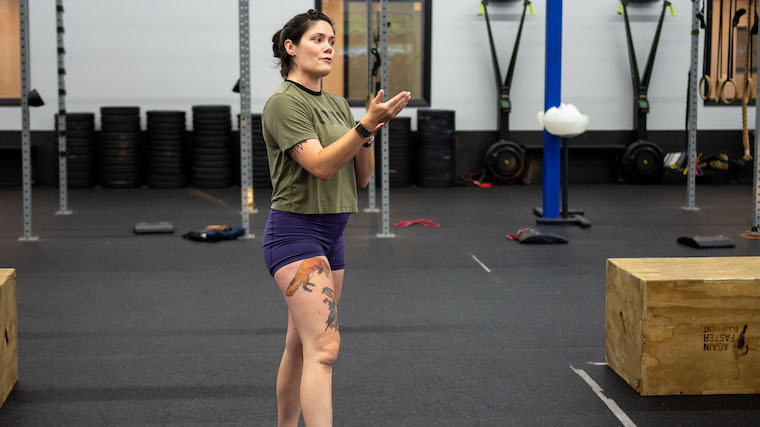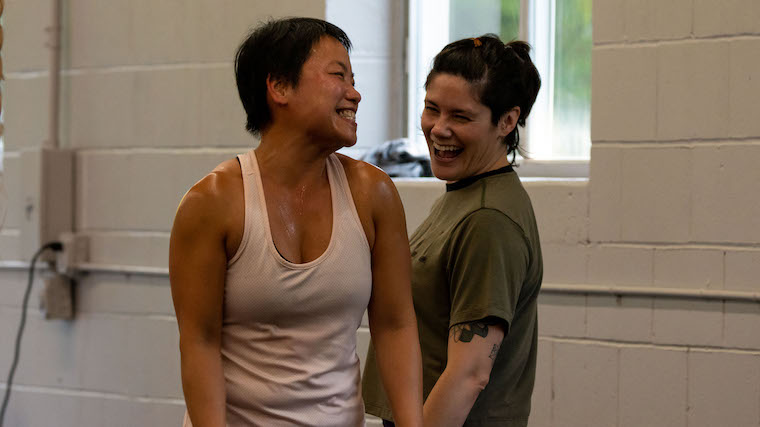As a mindset coach many athletes come to me with the question, “How do I get rid of self-doubt?” Athletes asking this question are usually under the assumption that self-doubt is negative, when self-doubt can actually be harnessed to serve their training goals.
Self-doubt can show up as nervousness before a session, where an athlete may question whether they can perform to internal or external standards set for them. It can also show up during a session or when performing a particular skill that feels harder than expected. Lastly, self-doubt can show up as questioning whether we’re doing “enough” or training “right.”
Instead of answering the question, “How do I get rid of self-doubt,” I’ll instead tell you how to harness self-doubt to maximize my performance.

Editor’s note: This article is an op-ed. The views expressed herein and in the video are the author’s and don’t necessarily reflect the views of BarBend. Claims, assertions, opinions, and quotes have been sourced exclusively by the author.
How Self-Doubt Can Hurt Our Performance
No emotion or thought has the power to change physical output; It’s when we attach meaning to those thoughts and emotions that they impact our workouts.
One of the ways self-doubt becomes detrimental to performance is when it morphs into self-consciousness, a hyper awareness of possible judgment from others. Self-consciousness causes us to lose “flow,” a state of full immersion in an activity. When one is concerned about how they appear to others, they can become distracted and rigid; movement becomes more stilted and uncertain and performance suffers.
Uncertainty about one’s progress or about modifications for a workout can also trigger self-doubt. In these cases, self-doubt can be a manifestation of low self-efficacy. Self-efficacy is the belief in our ability to overcome obstacles and achieve goals. Low self-efficacy is often accompanied by reduced self-belief, a cycle of believing we’re incapable, acting on that notion by not trying, and thereby reinforcing that belief.
Why Self-Doubt Can Be Positive
What meaning we attach to our emotions and thoughts matters when it comes to performance. Like any emotion, self-doubt is a signal from our subconscious to our conscious mind. How we interpret that signal is a choice, but the interpretation is often left to the subconscious and unquestioned. Bringing conscious perspective to self-doubt is key.
When it comes to the nervousness we feel before a workout, self-doubt is a positive signal that we’re getting out of our comfort zone. Think of it this way: the only way to train without any self-doubt is for the work to be so easy that physical adaptation doesn’t occur. Progress happens only when we get out of our comfort zone.
Self-doubt can also be a signal from our body that shows up as fear. For example, fear of going overhead or kicking into a handstand can be our body communicating a lack of stability in those positions. Listening to this signal by adjusting our progression may be necessary for our safety.
When self-doubt is the manifestation of low self-belief, we have a deeper examination to perform. Without owning low self-belief, we’ll be unable to break the cycle of belief-acting on the belief-reinforcement.
We may accept now that self-doubt can be a positive sign of impending progress, but as soon as we’re grinding through a tough WOD, habits of thought lead to self-consciousness and an athlete is right back where they started from.
To harness self-doubt, one must know how to anchor oneself with perspective and in the process. This technique works when a person is fearful of a movement and is a part of breaking the cycle of low self-efficacy and low self-belief. It starts with changing an individual’s subconscious interpretation of self-doubt.
Interpreting Adrenaline
The feeling one can get when they’re out of their comfort zone — shallow breathing, higher heart rate, butterflies in the stomach — is up to interpretation. People’s perception of what those physical signals of adrenaline mean matters.
Adrenaline is the hormone the body releases to get ready for danger. The increase in heart rate and blood pressure improves performance. “Danger” can be a social danger, like falling behind a training partner and fearing their judgment. Danger can also be physical, like getting into a position we aren’t comfortable in.
If we’ve learned to interpret nervousness as a sign that we’re failing or going to fail, we’ll be right. The perspective shift is this: getting uncomfortable is what makes progress possible. Therefore, we are on the right path, and this is exactly what we need to do to progress.
Interpreting Discomfort and Struggling
Discomfort in training comes in many flavors: A weight that feels heavier than expected; a movement that feels slower than expected; working at a pace that suddenly feels unsustainable.
Athletes often learn to interpret struggling as failure itself. This is a hallmark of what Dr. Carol Dweck calls the “fixed mindset.” In this belief system, feeling challenged by something is a sign that we’re not good enough. Effortlessness is the goal of the fixed mindset, and so effort itself feels like a failure.
Struggling in a training session is necessary for progress. When one instead learns to interpret being challenged by a workout as a positive experience, one that’s leading to growth, they will find that struggle feels easier to manage mentally.
How to Use Self-Doubt in Training
Now that you understand the need to experience doubt in training and have alternative perspectives to call on when experiencing self-doubt, you need to remind yourself of the process during workouts.
I train athletes to write down a short phrase each day that reminds them of the purpose of their training, who they are becoming through their daily acts, and what character they are striving to become. This sets them up for mental success before they’ve even entered the gym because they’re already primed to look for that greater perspective during the workout.
Then, athletes must practice internal boundary setting. Self-consciousness and low self-belief are accompanied by habitual thought and emotional patterns. When athletes can recognize those patterns, they are practicing metacognition. Metacognition is awareness of thought and emotion, essentially the ability to think about thinking.
Once athletes can think about their thinking, they have made subconscious patterns conscious ones, and this opens up the ability to choose to think, feel, and behave differently than we have before.
Internal boundary setting is a form of impulse control. The temptation to attach to the thoughts and emotions we experience during self-consciousness, fear, low self-belief, and nervousness is strong because it’s a habit.
Building the new thought habit is a four step process:
- Observe the thoughts and emotions,
- acknowledge the root of the pattern (fear of judgment, proving worth through achievement, etc),
- set the boundary (“we’re not thinking like that anymore”), and
- remind ourselves of our purpose that day (process of reaching a goal, practicing grit, etc).
Conclusion
The habits we’ve built in thought, emotion, and action, including how we interpret adrenaline and struggling, are breakable. The brain is adaptable with presence and intention. Unlearning our beliefs about self-doubt and relearning new ones takes conscious, careful reps.
